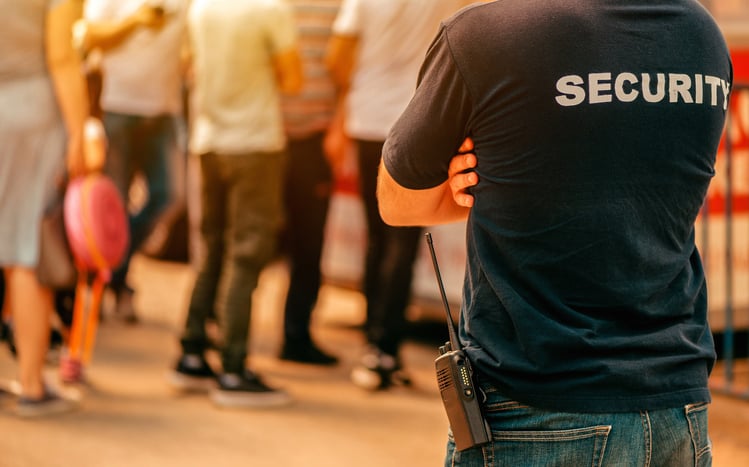The Difference Between Crowd Control and Static Security

Written by Asset College Security Trainer, Rebecca Hanckel
Static Security
The term ‘static security’ describes security functions that are mostly at one fixed location or in charge of one particular area such as at a gatehouse at the entrance to a construction site, or where someone is working in a loss prevention role at a retail store, checking customers bags upon exit for example.
This role or type of security is generally responsible for the protection of property, its access points, and the prevention of theft by being a visible deterrent. Another example would be a static security officer outside a financial institution.
Static security deals with potential threats to certain areas or sites, vandalism or property damage, theft and unauthorised access to sites or certain areas. Duties include conducting identification checks, securing entry/exit points, conducting searches, providing customer service to site visitors, providing them with directions and assistance, whilst granting them access to a site or an area, only after they have been checked and cleared.
Static security will often guard a temporary post where there may have been damage or a breach of some sort, and it requires a physical presence until such time as repairs can be made and the site can be secured. For example, someone has vandalised a shopping centre window late at night and a static guard will be called to stay there until the site can be repaired or secured once again.
Static guards may also patrol their particular area using their observation skills to detect unusual behaviour or signs of unauthorised access or forced entry, for example, someone cutting a whole in a fence at an industrial site and gaining access to the property.
In general terms, static security involves the protection of property at a particular location.
Crowd Control
The term ‘crowd control’ relates to the managing and regulating of people, their behaviour, and their protection when gathered in public places such as at an event, concert, shopping centre, hospitals, clubs and restaurants. The role or type of security work is generally responsible for the protection of people, so they can attend a venue and be provided a safe environment with minimal potential harm or nuisance from others.
Crowd control deals with the risks associated with large gatherings where is it possible to have crowd crushing, riots, public disturbances, or accidents. A large percentage of crowd control duties are required where alcohol and/or drugs are present – a music festival or a sporting event, the horse races, public event such as a community show, bars and clubs, some private gatherings where alcohol is served, just to name a few.
This role requires situational awareness skills by the crowd controllers to watch crowd behaviours and monitor changes within the crowd. They must be able to pre-empt escalations of conflict or other incidents at their earliest opportunity.
As part of the ability to manage conflict and use de-escalation techniques when dealing with groups of people, a crowd controller must intervene as soon as is possible and the most effective way to do this, is to pre-empt the conflict when possible. Good negotiation and communication skills are vital to effectively managing people and conflict, to best address the issues whilst maintaining a high level of professionalism with a focus to problem solve and find a win-win outcome.
Whilst the main difference between static security and crowd control in simple terms is “what the officer is protecting” – being property as a static guard and people as a crowd controller – there are many more similarities between the two types of roles.
Both types of security require good communication skills so they are able to give clear directions to others, effectively communicate with colleagues, negotiate and de-escalate any situation they may face.
Both types of security require alertness and observation skills, being able to detect potential risks or breaches, changes in their immediate environment, and respond accordingly, in a lawful, humane, and professional manner at all times.
Both require a high level of customer service skills, which include listening with a genuine desire to assist, knowing the scope of their role and what the company requirements are.
Both require good preparation and planning in the event of an incident, how they are to respond to a situation, who they are to contact, what the organisation’s policies and procedures are, and how they can mitigate potential threats by being best prepared, and to always remain safe.
Both require excellent teamwork. A static guard is usually part of a security team that are located elsewhere, where as a crowd controller may have other team members working alongside them. Both require the ability to collaborate, follow instructions or take control of a situation. Without good teamwork, security officer’s safety is at risk.
Often the use of surveillance equipment such as CCTV monitors can assist in both property protection and in public places for the purposes of crowd control, with operators communicating with officers so they may increase their presence at a certain potential conflict location and follow their standard operation procedures (SOPs) to best handle a situation in the safety way possible.
Many security officer roles are defined specifically as either static guard or crowd control, however some of the aspects of each type of security can cross to the other.
Are you interested in becoming a Security Officer? Find out more by attending one of our FREE security career information sessions!
